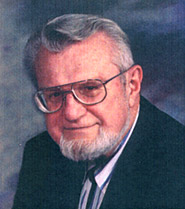Berkeleyan
Obituary
John Chemsak
![]()
26 September 2007
John Chemsak, an entomological researcher and curator long associated with the Essig Museum of Entomology at Berkeley, died Aug. 26 at the age of 75.
He was born in Ambridge, Penn., and attended public school there. He obtained his B.S and M.S. degrees in entomology at Penn State University in the 1950s.
 John Chemsak |
Chemsak came to Berkeley after developing an interest in longhorn beetles (Cerambycidae) and corresponding with E. G. Linsley, who was then chair of the Department of Entomology and Parasitology and a specialist in systematics of cerambycids. Chemsak worked as Linsley's research assistant while a graduate student, and together they completed the first five volumes of Linsley's monograph on North American species of longhorn beetles.
Following his doctoral research on the taxonomy and bionomics of the genus Tetraopes, Chemsak spent five years as a postdoctoral assistant research entomologist with Linsley, by then dean of the College of Agriculture. During that time they laid the foundation for the remaining five volumes of The Cerambycidae of North America, which were completed by Chemsak and published during the succeeding 30 years.
Starting in 1967, Chemsak was involved with the California Insect Survey, in a position he occupied for 32 years. He was also a curator in the Essig Museum of Entomology and carried out a highly productive research program on systematics of Cerambycidae, especially of Mexico and Central America. He wrote or co-wrote about 175 publications, describing about 570 species new to science and proposing 64 new genera and one new tribe.
In an era when biologists lament the loss of habitat and species worldwide, especially in the tropics, paradoxically descriptive taxonomy has fallen out of favor; few have done as much in the past 50 years as Chemsak to catalog and describe extant Neotropical fauna.
His taxonomic research was not confined to the Essig Museum. During 1957-2002, Chemsak made 50 expeditions to Mexico, Honduras, and Costa Rica in quest of longhorn beetles, collecting other insects extensively as well. He also conducted field work in French Guiana, Brazil, Hawaii, and Papua New Guinea, where he contracted malaria in 1994.
In addition, Chemsak carried out extensive field research in California and the southwestern U.S. He helped organize, plan logistics, and serve as cook for 15 "Spring Trips"- student-faculty insect-survey ventures to various parts of California. He made many other trips, especially to the Great Basin and desert parts of California and adjacent states, often accompanied by visiting coleopterists from Mexico and elsewhere.
Attesting to the diversity of collections that he made and people he assisted, there are at least 31 species and two genera named in his honor. More than half of them are longhorn beetles, described by 10 specialists in several countries, but in addition there are patronyms for new beetles of three other families and insects of four other orders - five true bugs (Hemiptera) in four families, one fly, five moths in four families, a wasp, and a bee.
Chemsak was appointed a Fellow of the California Academy of Sciences in 1971 and was a research associate of the Academy. He was president of the Pacific Coast Entomological Society (1973) and served as editor of the Pan-Pacific Entomologist for five years (1985-89), as well as a member of the editorial board for Publications in Entomology, a UC Press publication, for many years.
He is survived by his wife of 22 years, Hatsue Katsura, who often accompanied him on trips to Hawaii, Mexico, and Costa Rica; two daughters and a son from a former marriage; a sister; and two grandchildren. He is also survived by four stepsons and four granddaughters.
Donations in Chemsak's memory may be made to the Essig Museum of Entomology, 643-0804.
- J. A. Powell

